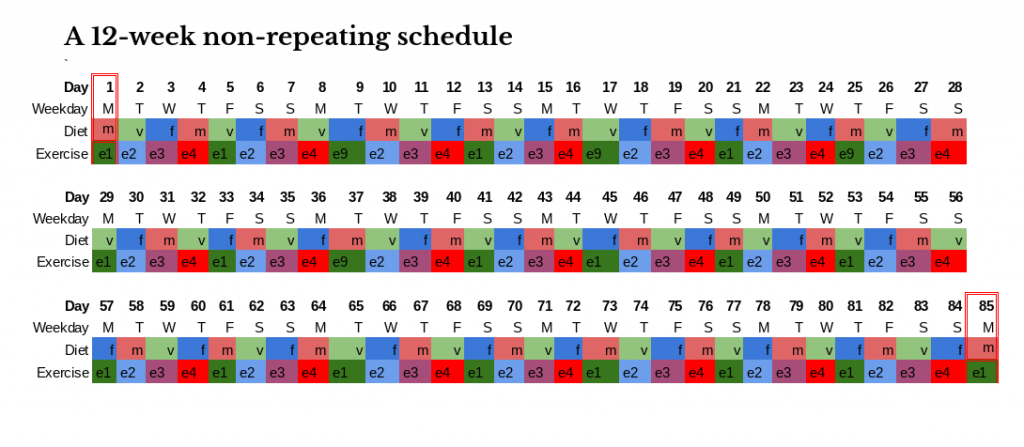Freeing ourselves from the shackles of a weekly routine can massively increase the variety of our daily lives, while helping ensure we do not overdo activities or get stuck in a rut. We can use some maths to help.
Breaking our weekly routine to have a varied combination of experiences and activities helps make our vacations memorable, stimulating and refreshing. And novelties and seeing new angles help slow our perception of time passing.
We are less likely to run out of new ideas if we also create novelty by combining existing activities in new ways, creating a new cocktail of activity. Doing this also allows us to keep the repetition necessary for learning and physical training.
Break seven
Say we work or study a seven day week and we want to eat a highly varied diet. One simple way to do this would be to give ourselves a daily meal suggestion: say one day meat, the next day vegetarian and the next day fish, and so on in rotation.
It is a very simple schedule, but because it breaks the seven day routine it creates huge variety. If we start on a Monday eating meat, for instance, it would take a full 21 days before we do so again (see diagram). You will see the same is also true for other day-meal combinations.

Now let’s say we create an exercise schedule following a four-day cycle, which offers a good effort-recovery rhythm. We might start with a day of one type of cardio paired with a day of recovery after, say, and then different cardio exercise and another day of recovery. In high intensity weight training it might be one session and then a full three days of recovery.
Either way we can reasonably expect sticking to a four-day training pattern would allow us a good balance between exercise and the rest we need before training again. Over-training is a sure way to undermine progress, feel worn out and potentially injury oneself.
Again, this four-day exercise pattern which does not fit neatly into a seven-day pattern. It would take 28 days before the same exercise fells on the same day (see below). This is not a bad thing. I means without effort that we can significantly vary our weekly experiences.

Now let’s say now we do both the rotating three-day diet suggestions and the four-day exercise programme in parallel. This takes it up another level. It would take a full 84 days before we have the same exercise and diet combination (see below).

So, in the case shown, we start the schedule on Monday doing exercise number one and eating meat, and it would be another 12 weeks before this combination happened again. Significant elements of every weekday in-between would be different.
And, of course, we don’t have to stick rigidly to such a schedule. In fact that would defeat the objective. If we want more rest or to make a change on the fly, then it’s no a problem. Our own recreation schedules are only ever a guideline.
Trying it
The activities of diet and exercise are arbitrary examples, of course. You might be wanting to weave together a programme of French language, computer programming and basket weaving. And the period of each cycle could be any length.
I chose exercise and diet because they were how I stumbled this idea. Initially I tried the two day alternating meal suggestion cycle. I noticed how it meant I did not eat the same type of food on the same day for a fortnight.
And then I settled on an exercise programme repeating every four days. Encouraged by the success of the alternating diet I adopted this exercise schedule, adding a third food category to avoid it synchronising with the exercise schedule. Et voila.
Why haven’t I done this before? For me it was because such complex schedules were hard to manage with pen and paper. This made me try to squeeze everything into a seven-day pattern regardless of physiology or monotony.
My habit of wanting to fit to the easily-remembered seven day weekly schedule has led me to programmes of overtraining, as I tried to squeeze eight days into seven. With other activities it has meant I am unable to “find time” for them. I am probably not alone.
Calendars and task management programs now make it far easier to divorce our recreations from the seven day grind of the work week. This can give a regular weekday some of the novel feel of a vacation.
*To work it out you generally just need to multiply the period of the routines, in this case 3x4x7. There is an exception for periods which are factors of longer schedules. ■